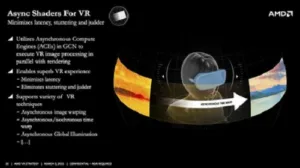Virtual Reality was a major talking point at this year’s Game Developers’ Conference, and AMD wasn’t letting the action pass it by. After all, a dedicated GPU will still be necessary to drive the best VR experiences.
LiquidVR is a new AMD technology, with an alpha version of the SDK available to developers now. Features are based around three core concepts: comfort (latency and warping); compatibility (working with multiple headsets, bypassing the operating system when necessary); and compelling content (supporting multi-GPU set-ups).
For the ‘comfort’ goal, LiquidVR has two features: ‘Latest Data Latch’ and ‘Asynchronous Shaders’. These work together to implement a single latency reduction and warping system. Asynchronous Shaders enables the modification of a rendered image via shaders before sending it to the headset, using tracking data to cut down on perceived latency. Latest Data Latch is how that data is collected. Asynch Shaders are able to shade a frame while the next frame is already being rendered.
The aim for compelling content is backed up by AMD’s Affinity Multi-GPU technology. Simply-put, this enables individual GPUs to be assigned to specific tasks, such as rendering an image only for the right eye. Some rendering pipeline optimisations are also part of this feature, says Anandtech, which eliminates some CPU overhead.
Finally, LiquidVR uses a technology called Direct-to-Display to achieve the goal of compatibility. By occasionally bypassing the OS and sending an image straight to the headset, latency is improved; and by limiting what the OS has to do, it is easier for AMD to support multiple headsets.
AMD demonstrated LiquidVR on a new, unannounced graphics card, commonly thought to be the R9 390X. While there is little official information available, leaks say that the 390X will be based on AMD’s Fiji XT GPU, with stacked high-bandwidth memory (HBM) and a hybrid ‘Hydra’ liquid cooling system. It is also said to have 4GB of HBM VRAM, 4,096-bit wide memory interface and bandwidth of 640GBps.

